Domino's Pizza: Entry Strategies, External Influences in China
VerifiedAdded on 2023/04/21
|13
|4807
|180
Report
AI Summary
This report examines Domino's Pizza's potential market entry strategies in Hangzhou, China, considering four primary modes: Foreign Direct Investment (FDI), franchising, licensing, and partnering. The analysis delves into the advantages and disadvantages of each approach, considering factors such as risk, control, and resource commitment. The report also assesses the external environment in China, focusing on political, economic, and financial influences that could impact Domino's expansion. It highlights the importance of understanding China's unique cultural and business landscape, including consumer behavior and government regulations. The report concludes by suggesting optimal strategies for Domino's to successfully enter and thrive in the Hangzhou market, taking into account the company's global experience and the specific challenges and opportunities presented by the Chinese market. The report also incorporates an introduction and conclusion, providing a structured framework for understanding the complexities of international business expansion.
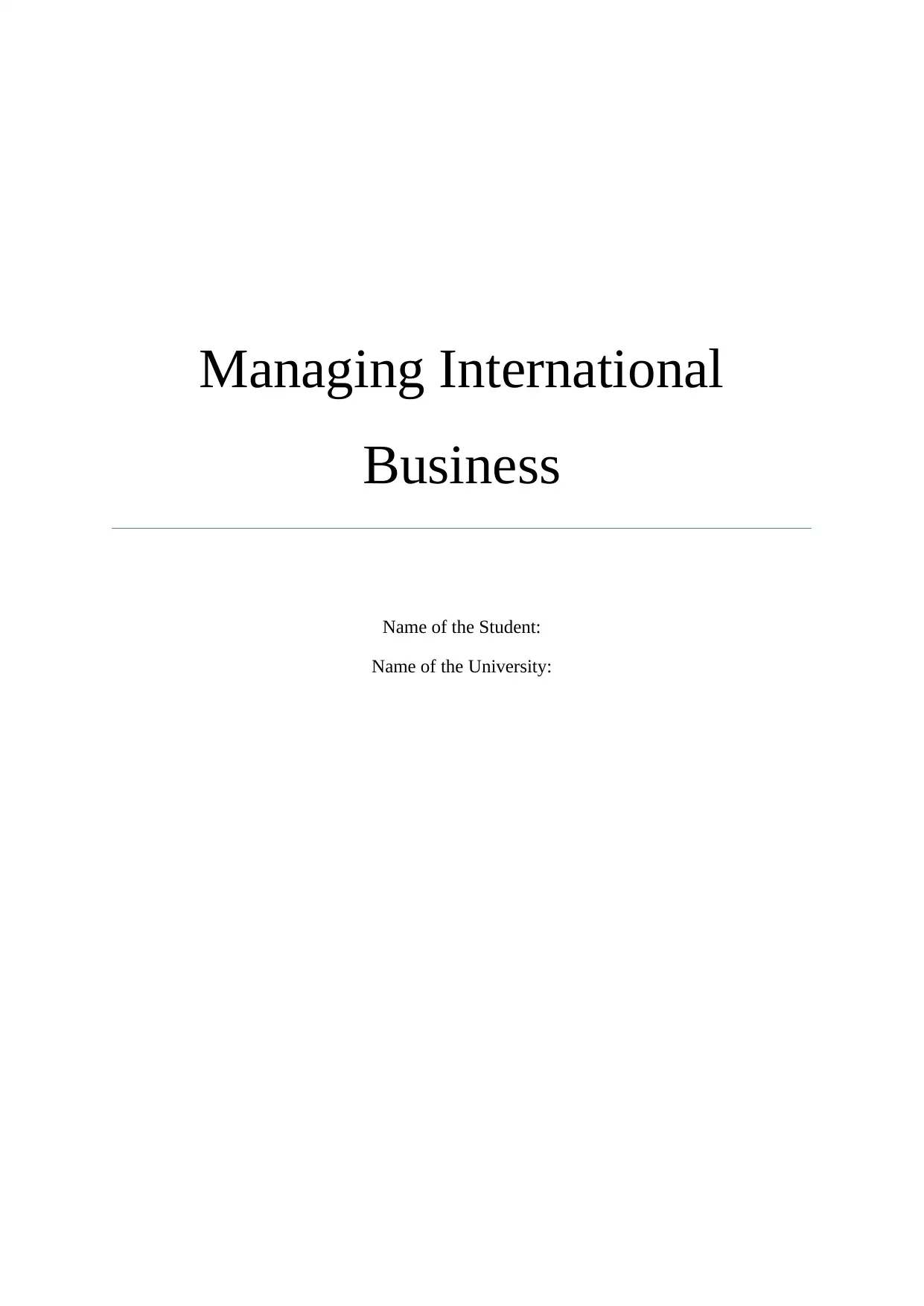
Managing International
Business
Name of the Student:
Name of the University:
Business
Name of the Student:
Name of the University:
Paraphrase This Document
Need a fresh take? Get an instant paraphrase of this document with our AI Paraphraser
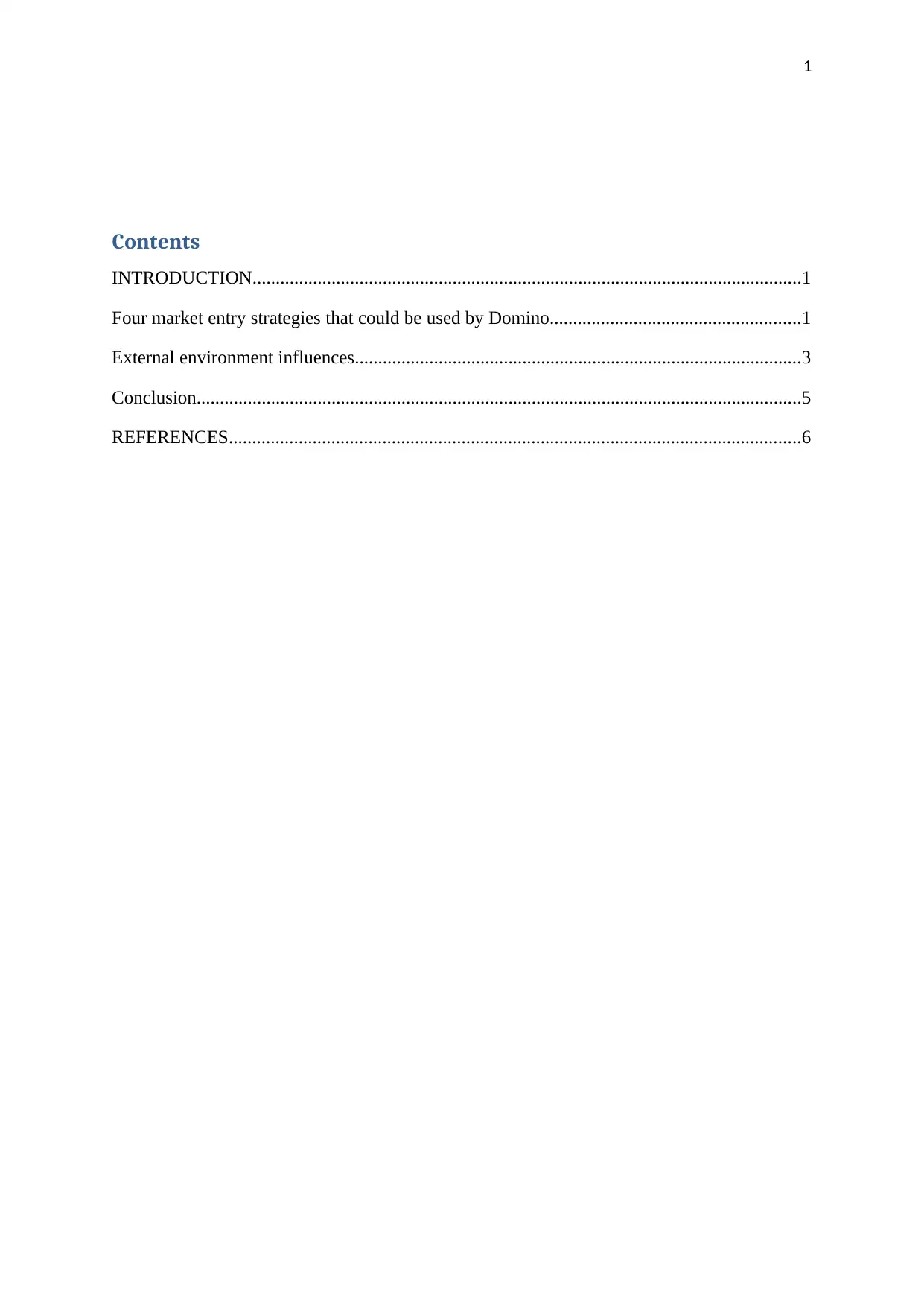
1
Contents
INTRODUCTION......................................................................................................................1
Four market entry strategies that could be used by Domino......................................................1
External environment influences................................................................................................3
Conclusion..................................................................................................................................5
REFERENCES...........................................................................................................................6
Contents
INTRODUCTION......................................................................................................................1
Four market entry strategies that could be used by Domino......................................................1
External environment influences................................................................................................3
Conclusion..................................................................................................................................5
REFERENCES...........................................................................................................................6
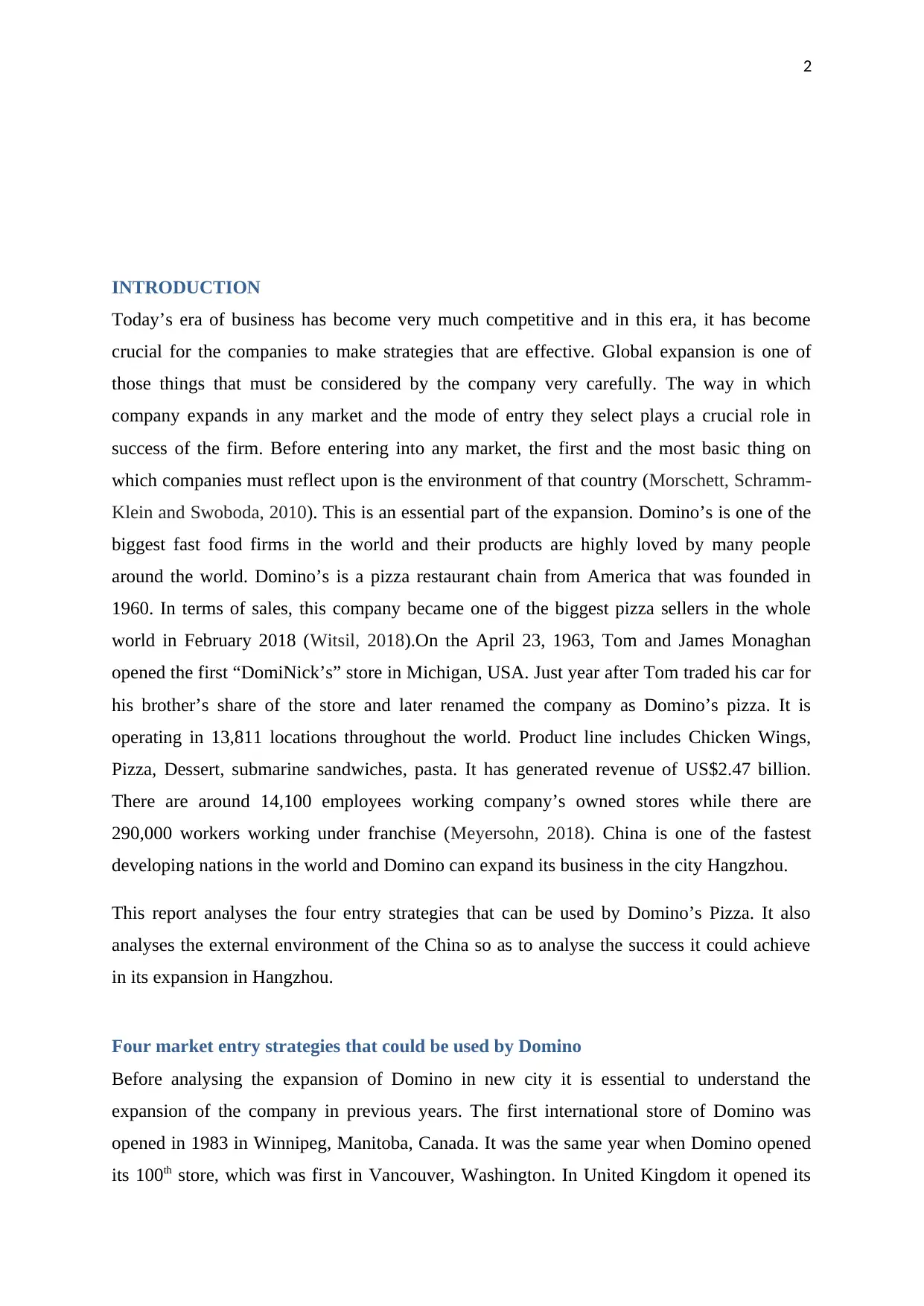
2
INTRODUCTION
Today’s era of business has become very much competitive and in this era, it has become
crucial for the companies to make strategies that are effective. Global expansion is one of
those things that must be considered by the company very carefully. The way in which
company expands in any market and the mode of entry they select plays a crucial role in
success of the firm. Before entering into any market, the first and the most basic thing on
which companies must reflect upon is the environment of that country (Morschett, Schramm-
Klein and Swoboda, 2010). This is an essential part of the expansion. Domino’s is one of the
biggest fast food firms in the world and their products are highly loved by many people
around the world. Domino’s is a pizza restaurant chain from America that was founded in
1960. In terms of sales, this company became one of the biggest pizza sellers in the whole
world in February 2018 (Witsil, 2018).On the April 23, 1963, Tom and James Monaghan
opened the first “DomiNick’s” store in Michigan, USA. Just year after Tom traded his car for
his brother’s share of the store and later renamed the company as Domino’s pizza. It is
operating in 13,811 locations throughout the world. Product line includes Chicken Wings,
Pizza, Dessert, submarine sandwiches, pasta. It has generated revenue of US$2.47 billion.
There are around 14,100 employees working company’s owned stores while there are
290,000 workers working under franchise (Meyersohn, 2018). China is one of the fastest
developing nations in the world and Domino can expand its business in the city Hangzhou.
This report analyses the four entry strategies that can be used by Domino’s Pizza. It also
analyses the external environment of the China so as to analyse the success it could achieve
in its expansion in Hangzhou.
Four market entry strategies that could be used by Domino
Before analysing the expansion of Domino in new city it is essential to understand the
expansion of the company in previous years. The first international store of Domino was
opened in 1983 in Winnipeg, Manitoba, Canada. It was the same year when Domino opened
its 100th store, which was first in Vancouver, Washington. In United Kingdom it opened its
INTRODUCTION
Today’s era of business has become very much competitive and in this era, it has become
crucial for the companies to make strategies that are effective. Global expansion is one of
those things that must be considered by the company very carefully. The way in which
company expands in any market and the mode of entry they select plays a crucial role in
success of the firm. Before entering into any market, the first and the most basic thing on
which companies must reflect upon is the environment of that country (Morschett, Schramm-
Klein and Swoboda, 2010). This is an essential part of the expansion. Domino’s is one of the
biggest fast food firms in the world and their products are highly loved by many people
around the world. Domino’s is a pizza restaurant chain from America that was founded in
1960. In terms of sales, this company became one of the biggest pizza sellers in the whole
world in February 2018 (Witsil, 2018).On the April 23, 1963, Tom and James Monaghan
opened the first “DomiNick’s” store in Michigan, USA. Just year after Tom traded his car for
his brother’s share of the store and later renamed the company as Domino’s pizza. It is
operating in 13,811 locations throughout the world. Product line includes Chicken Wings,
Pizza, Dessert, submarine sandwiches, pasta. It has generated revenue of US$2.47 billion.
There are around 14,100 employees working company’s owned stores while there are
290,000 workers working under franchise (Meyersohn, 2018). China is one of the fastest
developing nations in the world and Domino can expand its business in the city Hangzhou.
This report analyses the four entry strategies that can be used by Domino’s Pizza. It also
analyses the external environment of the China so as to analyse the success it could achieve
in its expansion in Hangzhou.
Four market entry strategies that could be used by Domino
Before analysing the expansion of Domino in new city it is essential to understand the
expansion of the company in previous years. The first international store of Domino was
opened in 1983 in Winnipeg, Manitoba, Canada. It was the same year when Domino opened
its 100th store, which was first in Vancouver, Washington. In United Kingdom it opened its
⊘ This is a preview!⊘
Do you want full access?
Subscribe today to unlock all pages.

Trusted by 1+ million students worldwide
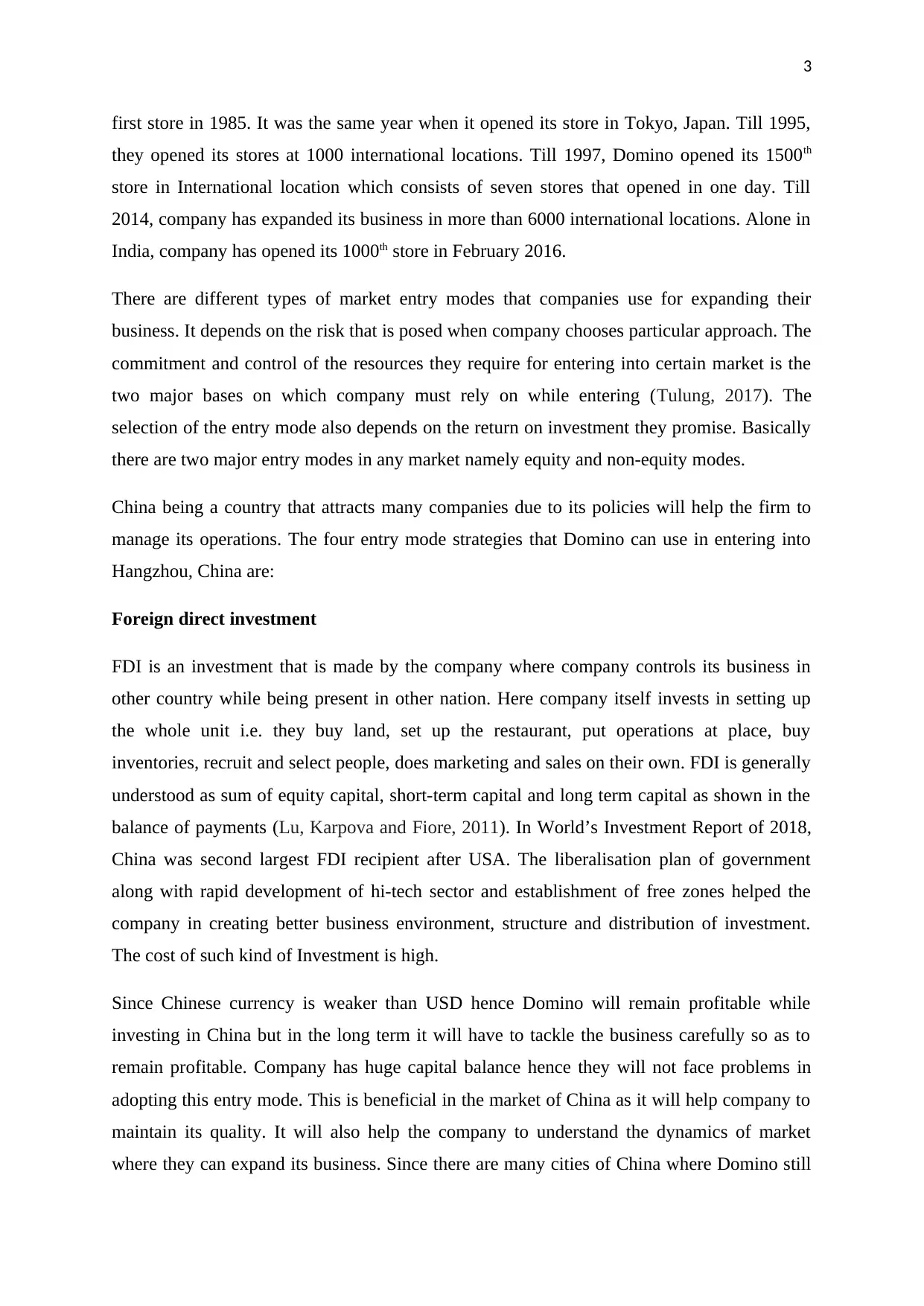
3
first store in 1985. It was the same year when it opened its store in Tokyo, Japan. Till 1995,
they opened its stores at 1000 international locations. Till 1997, Domino opened its 1500th
store in International location which consists of seven stores that opened in one day. Till
2014, company has expanded its business in more than 6000 international locations. Alone in
India, company has opened its 1000th store in February 2016.
There are different types of market entry modes that companies use for expanding their
business. It depends on the risk that is posed when company chooses particular approach. The
commitment and control of the resources they require for entering into certain market is the
two major bases on which company must rely on while entering (Tulung, 2017). The
selection of the entry mode also depends on the return on investment they promise. Basically
there are two major entry modes in any market namely equity and non-equity modes.
China being a country that attracts many companies due to its policies will help the firm to
manage its operations. The four entry mode strategies that Domino can use in entering into
Hangzhou, China are:
Foreign direct investment
FDI is an investment that is made by the company where company controls its business in
other country while being present in other nation. Here company itself invests in setting up
the whole unit i.e. they buy land, set up the restaurant, put operations at place, buy
inventories, recruit and select people, does marketing and sales on their own. FDI is generally
understood as sum of equity capital, short-term capital and long term capital as shown in the
balance of payments (Lu, Karpova and Fiore, 2011). In World’s Investment Report of 2018,
China was second largest FDI recipient after USA. The liberalisation plan of government
along with rapid development of hi-tech sector and establishment of free zones helped the
company in creating better business environment, structure and distribution of investment.
The cost of such kind of Investment is high.
Since Chinese currency is weaker than USD hence Domino will remain profitable while
investing in China but in the long term it will have to tackle the business carefully so as to
remain profitable. Company has huge capital balance hence they will not face problems in
adopting this entry mode. This is beneficial in the market of China as it will help company to
maintain its quality. It will also help the company to understand the dynamics of market
where they can expand its business. Since there are many cities of China where Domino still
first store in 1985. It was the same year when it opened its store in Tokyo, Japan. Till 1995,
they opened its stores at 1000 international locations. Till 1997, Domino opened its 1500th
store in International location which consists of seven stores that opened in one day. Till
2014, company has expanded its business in more than 6000 international locations. Alone in
India, company has opened its 1000th store in February 2016.
There are different types of market entry modes that companies use for expanding their
business. It depends on the risk that is posed when company chooses particular approach. The
commitment and control of the resources they require for entering into certain market is the
two major bases on which company must rely on while entering (Tulung, 2017). The
selection of the entry mode also depends on the return on investment they promise. Basically
there are two major entry modes in any market namely equity and non-equity modes.
China being a country that attracts many companies due to its policies will help the firm to
manage its operations. The four entry mode strategies that Domino can use in entering into
Hangzhou, China are:
Foreign direct investment
FDI is an investment that is made by the company where company controls its business in
other country while being present in other nation. Here company itself invests in setting up
the whole unit i.e. they buy land, set up the restaurant, put operations at place, buy
inventories, recruit and select people, does marketing and sales on their own. FDI is generally
understood as sum of equity capital, short-term capital and long term capital as shown in the
balance of payments (Lu, Karpova and Fiore, 2011). In World’s Investment Report of 2018,
China was second largest FDI recipient after USA. The liberalisation plan of government
along with rapid development of hi-tech sector and establishment of free zones helped the
company in creating better business environment, structure and distribution of investment.
The cost of such kind of Investment is high.
Since Chinese currency is weaker than USD hence Domino will remain profitable while
investing in China but in the long term it will have to tackle the business carefully so as to
remain profitable. Company has huge capital balance hence they will not face problems in
adopting this entry mode. This is beneficial in the market of China as it will help company to
maintain its quality. It will also help the company to understand the dynamics of market
where they can expand its business. Since there are many cities of China where Domino still
Paraphrase This Document
Need a fresh take? Get an instant paraphrase of this document with our AI Paraphraser
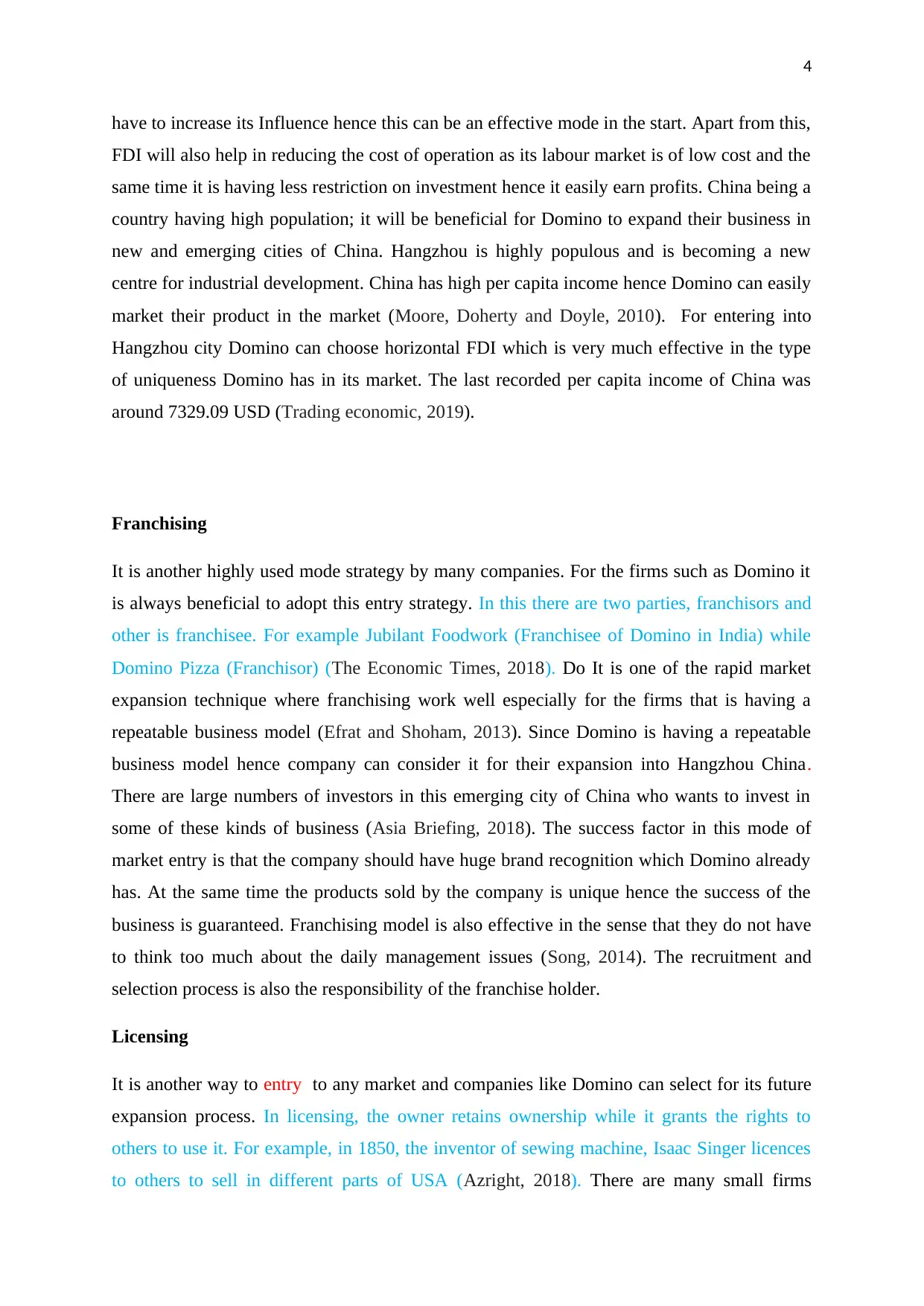
4
have to increase its Influence hence this can be an effective mode in the start. Apart from this,
FDI will also help in reducing the cost of operation as its labour market is of low cost and the
same time it is having less restriction on investment hence it easily earn profits. China being a
country having high population; it will be beneficial for Domino to expand their business in
new and emerging cities of China. Hangzhou is highly populous and is becoming a new
centre for industrial development. China has high per capita income hence Domino can easily
market their product in the market (Moore, Doherty and Doyle, 2010). For entering into
Hangzhou city Domino can choose horizontal FDI which is very much effective in the type
of uniqueness Domino has in its market. The last recorded per capita income of China was
around 7329.09 USD (Trading economic, 2019).
Franchising
It is another highly used mode strategy by many companies. For the firms such as Domino it
is always beneficial to adopt this entry strategy. In this there are two parties, franchisors and
other is franchisee. For example Jubilant Foodwork (Franchisee of Domino in India) while
Domino Pizza (Franchisor) (The Economic Times, 2018). Do It is one of the rapid market
expansion technique where franchising work well especially for the firms that is having a
repeatable business model (Efrat and Shoham, 2013). Since Domino is having a repeatable
business model hence company can consider it for their expansion into Hangzhou China.
There are large numbers of investors in this emerging city of China who wants to invest in
some of these kinds of business (Asia Briefing, 2018). The success factor in this mode of
market entry is that the company should have huge brand recognition which Domino already
has. At the same time the products sold by the company is unique hence the success of the
business is guaranteed. Franchising model is also effective in the sense that they do not have
to think too much about the daily management issues (Song, 2014). The recruitment and
selection process is also the responsibility of the franchise holder.
Licensing
It is another way to entry to any market and companies like Domino can select for its future
expansion process. In licensing, the owner retains ownership while it grants the rights to
others to use it. For example, in 1850, the inventor of sewing machine, Isaac Singer licences
to others to sell in different parts of USA (Azright, 2018). There are many small firms
have to increase its Influence hence this can be an effective mode in the start. Apart from this,
FDI will also help in reducing the cost of operation as its labour market is of low cost and the
same time it is having less restriction on investment hence it easily earn profits. China being a
country having high population; it will be beneficial for Domino to expand their business in
new and emerging cities of China. Hangzhou is highly populous and is becoming a new
centre for industrial development. China has high per capita income hence Domino can easily
market their product in the market (Moore, Doherty and Doyle, 2010). For entering into
Hangzhou city Domino can choose horizontal FDI which is very much effective in the type
of uniqueness Domino has in its market. The last recorded per capita income of China was
around 7329.09 USD (Trading economic, 2019).
Franchising
It is another highly used mode strategy by many companies. For the firms such as Domino it
is always beneficial to adopt this entry strategy. In this there are two parties, franchisors and
other is franchisee. For example Jubilant Foodwork (Franchisee of Domino in India) while
Domino Pizza (Franchisor) (The Economic Times, 2018). Do It is one of the rapid market
expansion technique where franchising work well especially for the firms that is having a
repeatable business model (Efrat and Shoham, 2013). Since Domino is having a repeatable
business model hence company can consider it for their expansion into Hangzhou China.
There are large numbers of investors in this emerging city of China who wants to invest in
some of these kinds of business (Asia Briefing, 2018). The success factor in this mode of
market entry is that the company should have huge brand recognition which Domino already
has. At the same time the products sold by the company is unique hence the success of the
business is guaranteed. Franchising model is also effective in the sense that they do not have
to think too much about the daily management issues (Song, 2014). The recruitment and
selection process is also the responsibility of the franchise holder.
Licensing
It is another way to entry to any market and companies like Domino can select for its future
expansion process. In licensing, the owner retains ownership while it grants the rights to
others to use it. For example, in 1850, the inventor of sewing machine, Isaac Singer licences
to others to sell in different parts of USA (Azright, 2018). There are many small firms
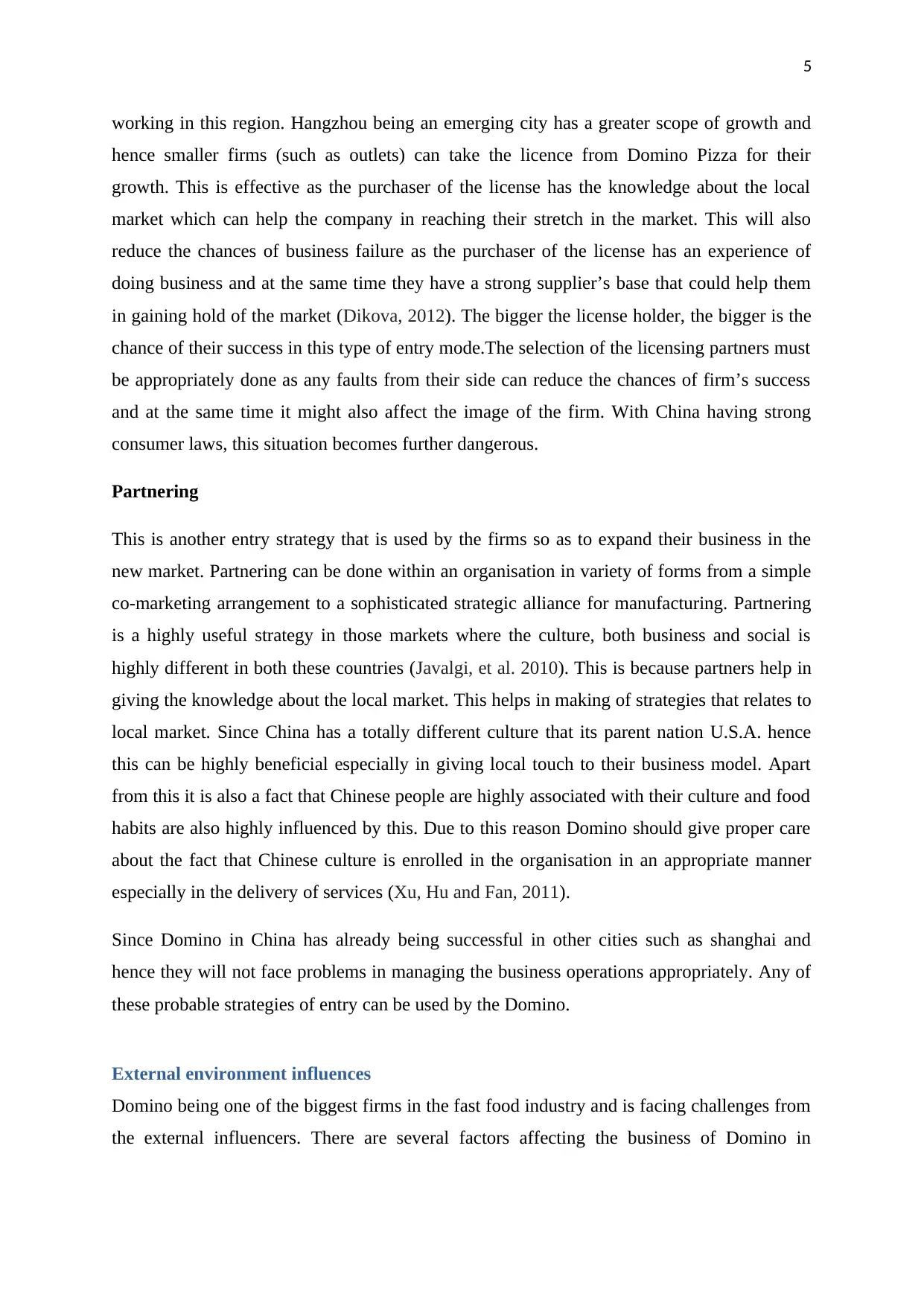
5
working in this region. Hangzhou being an emerging city has a greater scope of growth and
hence smaller firms (such as outlets) can take the licence from Domino Pizza for their
growth. This is effective as the purchaser of the license has the knowledge about the local
market which can help the company in reaching their stretch in the market. This will also
reduce the chances of business failure as the purchaser of the license has an experience of
doing business and at the same time they have a strong supplier’s base that could help them
in gaining hold of the market (Dikova, 2012). The bigger the license holder, the bigger is the
chance of their success in this type of entry mode.The selection of the licensing partners must
be appropriately done as any faults from their side can reduce the chances of firm’s success
and at the same time it might also affect the image of the firm. With China having strong
consumer laws, this situation becomes further dangerous.
Partnering
This is another entry strategy that is used by the firms so as to expand their business in the
new market. Partnering can be done within an organisation in variety of forms from a simple
co-marketing arrangement to a sophisticated strategic alliance for manufacturing. Partnering
is a highly useful strategy in those markets where the culture, both business and social is
highly different in both these countries (Javalgi, et al. 2010). This is because partners help in
giving the knowledge about the local market. This helps in making of strategies that relates to
local market. Since China has a totally different culture that its parent nation U.S.A. hence
this can be highly beneficial especially in giving local touch to their business model. Apart
from this it is also a fact that Chinese people are highly associated with their culture and food
habits are also highly influenced by this. Due to this reason Domino should give proper care
about the fact that Chinese culture is enrolled in the organisation in an appropriate manner
especially in the delivery of services (Xu, Hu and Fan, 2011).
Since Domino in China has already being successful in other cities such as shanghai and
hence they will not face problems in managing the business operations appropriately. Any of
these probable strategies of entry can be used by the Domino.
External environment influences
Domino being one of the biggest firms in the fast food industry and is facing challenges from
the external influencers. There are several factors affecting the business of Domino in
working in this region. Hangzhou being an emerging city has a greater scope of growth and
hence smaller firms (such as outlets) can take the licence from Domino Pizza for their
growth. This is effective as the purchaser of the license has the knowledge about the local
market which can help the company in reaching their stretch in the market. This will also
reduce the chances of business failure as the purchaser of the license has an experience of
doing business and at the same time they have a strong supplier’s base that could help them
in gaining hold of the market (Dikova, 2012). The bigger the license holder, the bigger is the
chance of their success in this type of entry mode.The selection of the licensing partners must
be appropriately done as any faults from their side can reduce the chances of firm’s success
and at the same time it might also affect the image of the firm. With China having strong
consumer laws, this situation becomes further dangerous.
Partnering
This is another entry strategy that is used by the firms so as to expand their business in the
new market. Partnering can be done within an organisation in variety of forms from a simple
co-marketing arrangement to a sophisticated strategic alliance for manufacturing. Partnering
is a highly useful strategy in those markets where the culture, both business and social is
highly different in both these countries (Javalgi, et al. 2010). This is because partners help in
giving the knowledge about the local market. This helps in making of strategies that relates to
local market. Since China has a totally different culture that its parent nation U.S.A. hence
this can be highly beneficial especially in giving local touch to their business model. Apart
from this it is also a fact that Chinese people are highly associated with their culture and food
habits are also highly influenced by this. Due to this reason Domino should give proper care
about the fact that Chinese culture is enrolled in the organisation in an appropriate manner
especially in the delivery of services (Xu, Hu and Fan, 2011).
Since Domino in China has already being successful in other cities such as shanghai and
hence they will not face problems in managing the business operations appropriately. Any of
these probable strategies of entry can be used by the Domino.
External environment influences
Domino being one of the biggest firms in the fast food industry and is facing challenges from
the external influencers. There are several factors affecting the business of Domino in
⊘ This is a preview!⊘
Do you want full access?
Subscribe today to unlock all pages.

Trusted by 1+ million students worldwide
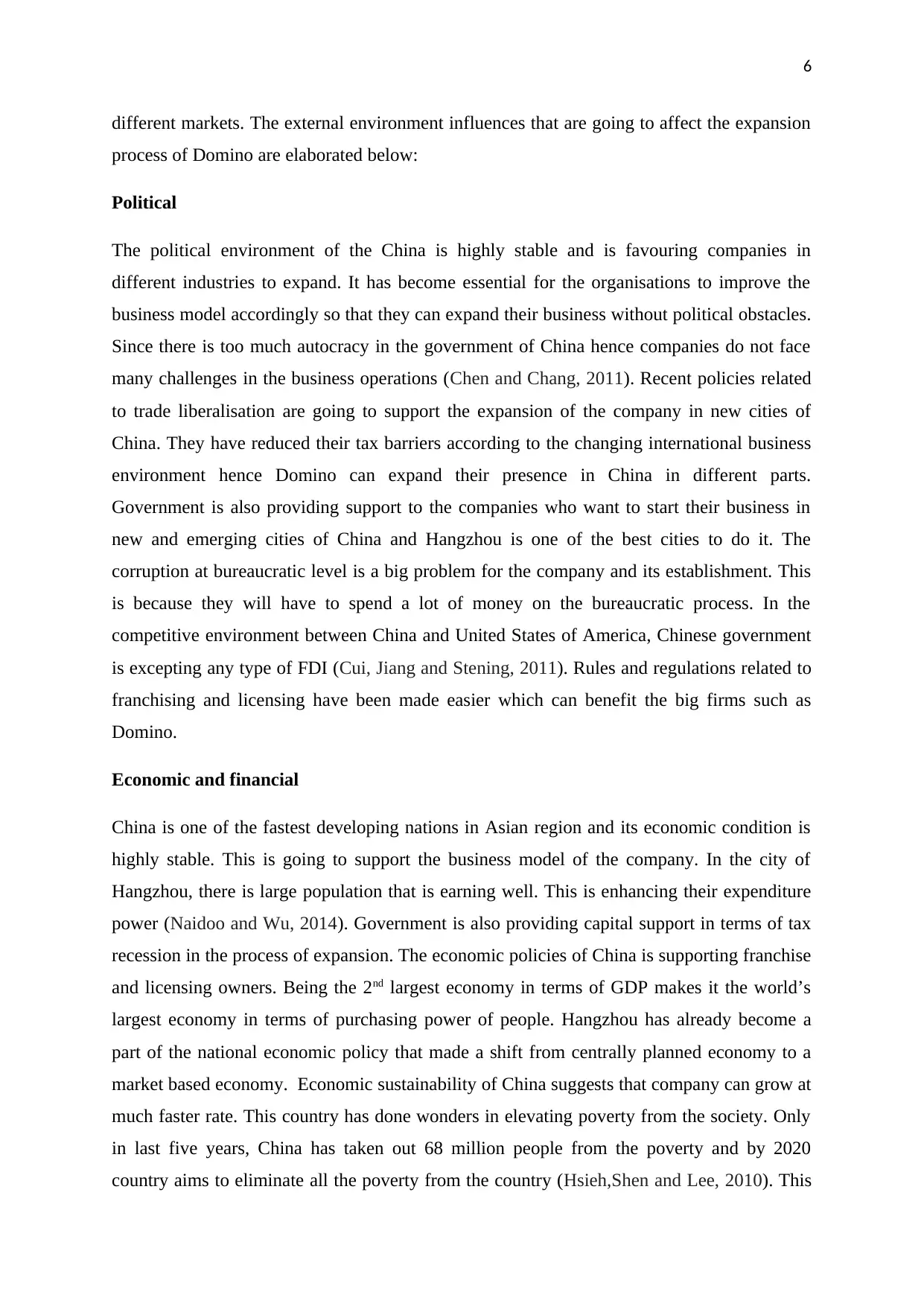
6
different markets. The external environment influences that are going to affect the expansion
process of Domino are elaborated below:
Political
The political environment of the China is highly stable and is favouring companies in
different industries to expand. It has become essential for the organisations to improve the
business model accordingly so that they can expand their business without political obstacles.
Since there is too much autocracy in the government of China hence companies do not face
many challenges in the business operations (Chen and Chang, 2011). Recent policies related
to trade liberalisation are going to support the expansion of the company in new cities of
China. They have reduced their tax barriers according to the changing international business
environment hence Domino can expand their presence in China in different parts.
Government is also providing support to the companies who want to start their business in
new and emerging cities of China and Hangzhou is one of the best cities to do it. The
corruption at bureaucratic level is a big problem for the company and its establishment. This
is because they will have to spend a lot of money on the bureaucratic process. In the
competitive environment between China and United States of America, Chinese government
is excepting any type of FDI (Cui, Jiang and Stening, 2011). Rules and regulations related to
franchising and licensing have been made easier which can benefit the big firms such as
Domino.
Economic and financial
China is one of the fastest developing nations in Asian region and its economic condition is
highly stable. This is going to support the business model of the company. In the city of
Hangzhou, there is large population that is earning well. This is enhancing their expenditure
power (Naidoo and Wu, 2014). Government is also providing capital support in terms of tax
recession in the process of expansion. The economic policies of China is supporting franchise
and licensing owners. Being the 2nd largest economy in terms of GDP makes it the world’s
largest economy in terms of purchasing power of people. Hangzhou has already become a
part of the national economic policy that made a shift from centrally planned economy to a
market based economy. Economic sustainability of China suggests that company can grow at
much faster rate. This country has done wonders in elevating poverty from the society. Only
in last five years, China has taken out 68 million people from the poverty and by 2020
country aims to eliminate all the poverty from the country (Hsieh,Shen and Lee, 2010). This
different markets. The external environment influences that are going to affect the expansion
process of Domino are elaborated below:
Political
The political environment of the China is highly stable and is favouring companies in
different industries to expand. It has become essential for the organisations to improve the
business model accordingly so that they can expand their business without political obstacles.
Since there is too much autocracy in the government of China hence companies do not face
many challenges in the business operations (Chen and Chang, 2011). Recent policies related
to trade liberalisation are going to support the expansion of the company in new cities of
China. They have reduced their tax barriers according to the changing international business
environment hence Domino can expand their presence in China in different parts.
Government is also providing support to the companies who want to start their business in
new and emerging cities of China and Hangzhou is one of the best cities to do it. The
corruption at bureaucratic level is a big problem for the company and its establishment. This
is because they will have to spend a lot of money on the bureaucratic process. In the
competitive environment between China and United States of America, Chinese government
is excepting any type of FDI (Cui, Jiang and Stening, 2011). Rules and regulations related to
franchising and licensing have been made easier which can benefit the big firms such as
Domino.
Economic and financial
China is one of the fastest developing nations in Asian region and its economic condition is
highly stable. This is going to support the business model of the company. In the city of
Hangzhou, there is large population that is earning well. This is enhancing their expenditure
power (Naidoo and Wu, 2014). Government is also providing capital support in terms of tax
recession in the process of expansion. The economic policies of China is supporting franchise
and licensing owners. Being the 2nd largest economy in terms of GDP makes it the world’s
largest economy in terms of purchasing power of people. Hangzhou has already become a
part of the national economic policy that made a shift from centrally planned economy to a
market based economy. Economic sustainability of China suggests that company can grow at
much faster rate. This country has done wonders in elevating poverty from the society. Only
in last five years, China has taken out 68 million people from the poverty and by 2020
country aims to eliminate all the poverty from the country (Hsieh,Shen and Lee, 2010). This
Paraphrase This Document
Need a fresh take? Get an instant paraphrase of this document with our AI Paraphraser
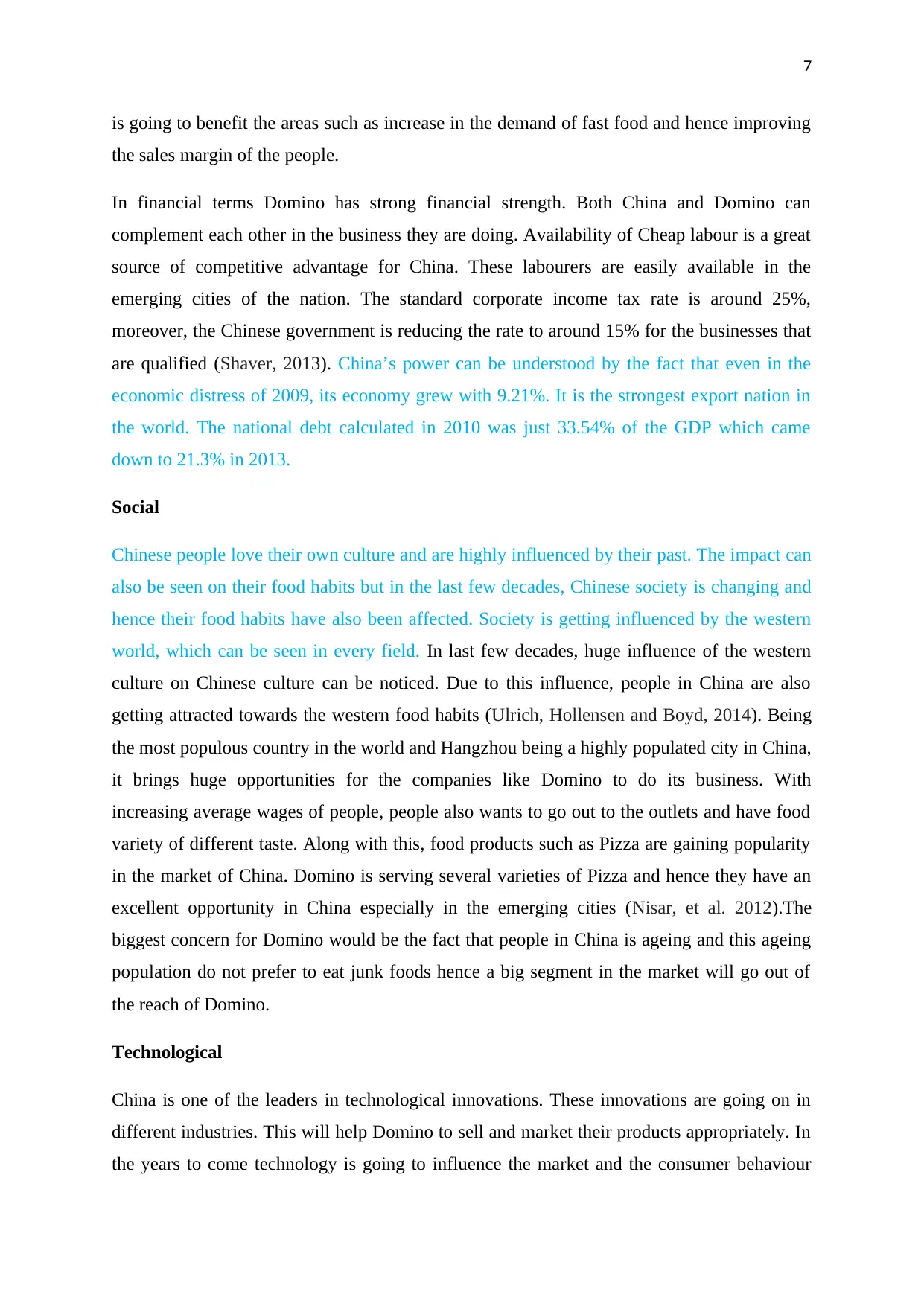
7
is going to benefit the areas such as increase in the demand of fast food and hence improving
the sales margin of the people.
In financial terms Domino has strong financial strength. Both China and Domino can
complement each other in the business they are doing. Availability of Cheap labour is a great
source of competitive advantage for China. These labourers are easily available in the
emerging cities of the nation. The standard corporate income tax rate is around 25%,
moreover, the Chinese government is reducing the rate to around 15% for the businesses that
are qualified (Shaver, 2013). China’s power can be understood by the fact that even in the
economic distress of 2009, its economy grew with 9.21%. It is the strongest export nation in
the world. The national debt calculated in 2010 was just 33.54% of the GDP which came
down to 21.3% in 2013.
Social
Chinese people love their own culture and are highly influenced by their past. The impact can
also be seen on their food habits but in the last few decades, Chinese society is changing and
hence their food habits have also been affected. Society is getting influenced by the western
world, which can be seen in every field. In last few decades, huge influence of the western
culture on Chinese culture can be noticed. Due to this influence, people in China are also
getting attracted towards the western food habits (Ulrich, Hollensen and Boyd, 2014). Being
the most populous country in the world and Hangzhou being a highly populated city in China,
it brings huge opportunities for the companies like Domino to do its business. With
increasing average wages of people, people also wants to go out to the outlets and have food
variety of different taste. Along with this, food products such as Pizza are gaining popularity
in the market of China. Domino is serving several varieties of Pizza and hence they have an
excellent opportunity in China especially in the emerging cities (Nisar, et al. 2012).The
biggest concern for Domino would be the fact that people in China is ageing and this ageing
population do not prefer to eat junk foods hence a big segment in the market will go out of
the reach of Domino.
Technological
China is one of the leaders in technological innovations. These innovations are going on in
different industries. This will help Domino to sell and market their products appropriately. In
the years to come technology is going to influence the market and the consumer behaviour
is going to benefit the areas such as increase in the demand of fast food and hence improving
the sales margin of the people.
In financial terms Domino has strong financial strength. Both China and Domino can
complement each other in the business they are doing. Availability of Cheap labour is a great
source of competitive advantage for China. These labourers are easily available in the
emerging cities of the nation. The standard corporate income tax rate is around 25%,
moreover, the Chinese government is reducing the rate to around 15% for the businesses that
are qualified (Shaver, 2013). China’s power can be understood by the fact that even in the
economic distress of 2009, its economy grew with 9.21%. It is the strongest export nation in
the world. The national debt calculated in 2010 was just 33.54% of the GDP which came
down to 21.3% in 2013.
Social
Chinese people love their own culture and are highly influenced by their past. The impact can
also be seen on their food habits but in the last few decades, Chinese society is changing and
hence their food habits have also been affected. Society is getting influenced by the western
world, which can be seen in every field. In last few decades, huge influence of the western
culture on Chinese culture can be noticed. Due to this influence, people in China are also
getting attracted towards the western food habits (Ulrich, Hollensen and Boyd, 2014). Being
the most populous country in the world and Hangzhou being a highly populated city in China,
it brings huge opportunities for the companies like Domino to do its business. With
increasing average wages of people, people also wants to go out to the outlets and have food
variety of different taste. Along with this, food products such as Pizza are gaining popularity
in the market of China. Domino is serving several varieties of Pizza and hence they have an
excellent opportunity in China especially in the emerging cities (Nisar, et al. 2012).The
biggest concern for Domino would be the fact that people in China is ageing and this ageing
population do not prefer to eat junk foods hence a big segment in the market will go out of
the reach of Domino.
Technological
China is one of the leaders in technological innovations. These innovations are going on in
different industries. This will help Domino to sell and market their products appropriately. In
the years to come technology is going to influence the market and the consumer behaviour
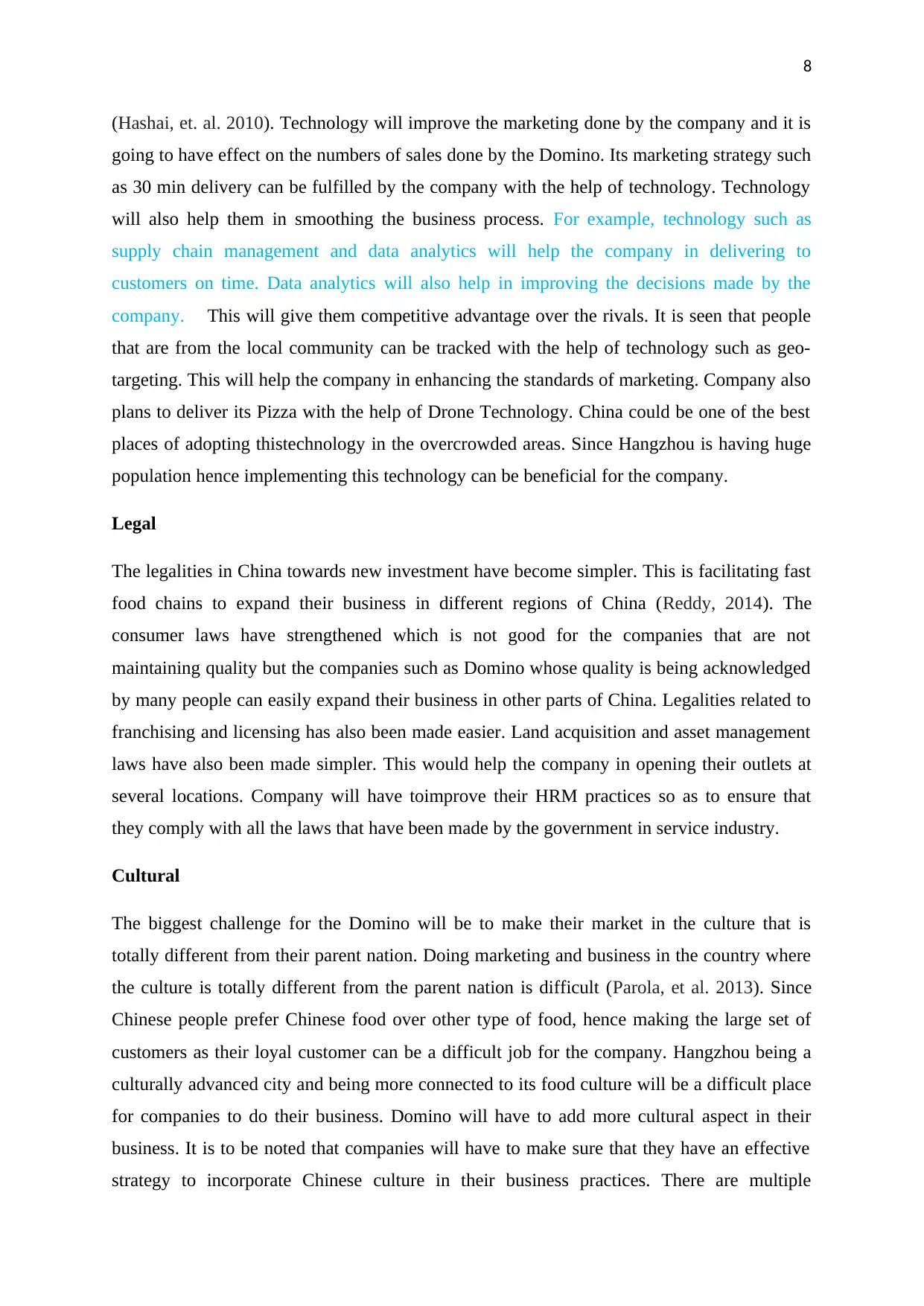
8
(Hashai, et. al. 2010). Technology will improve the marketing done by the company and it is
going to have effect on the numbers of sales done by the Domino. Its marketing strategy such
as 30 min delivery can be fulfilled by the company with the help of technology. Technology
will also help them in smoothing the business process. For example, technology such as
supply chain management and data analytics will help the company in delivering to
customers on time. Data analytics will also help in improving the decisions made by the
company. This will give them competitive advantage over the rivals. It is seen that people
that are from the local community can be tracked with the help of technology such as geo-
targeting. This will help the company in enhancing the standards of marketing. Company also
plans to deliver its Pizza with the help of Drone Technology. China could be one of the best
places of adopting thistechnology in the overcrowded areas. Since Hangzhou is having huge
population hence implementing this technology can be beneficial for the company.
Legal
The legalities in China towards new investment have become simpler. This is facilitating fast
food chains to expand their business in different regions of China (Reddy, 2014). The
consumer laws have strengthened which is not good for the companies that are not
maintaining quality but the companies such as Domino whose quality is being acknowledged
by many people can easily expand their business in other parts of China. Legalities related to
franchising and licensing has also been made easier. Land acquisition and asset management
laws have also been made simpler. This would help the company in opening their outlets at
several locations. Company will have toimprove their HRM practices so as to ensure that
they comply with all the laws that have been made by the government in service industry.
Cultural
The biggest challenge for the Domino will be to make their market in the culture that is
totally different from their parent nation. Doing marketing and business in the country where
the culture is totally different from the parent nation is difficult (Parola, et al. 2013). Since
Chinese people prefer Chinese food over other type of food, hence making the large set of
customers as their loyal customer can be a difficult job for the company. Hangzhou being a
culturally advanced city and being more connected to its food culture will be a difficult place
for companies to do their business. Domino will have to add more cultural aspect in their
business. It is to be noted that companies will have to make sure that they have an effective
strategy to incorporate Chinese culture in their business practices. There are multiple
(Hashai, et. al. 2010). Technology will improve the marketing done by the company and it is
going to have effect on the numbers of sales done by the Domino. Its marketing strategy such
as 30 min delivery can be fulfilled by the company with the help of technology. Technology
will also help them in smoothing the business process. For example, technology such as
supply chain management and data analytics will help the company in delivering to
customers on time. Data analytics will also help in improving the decisions made by the
company. This will give them competitive advantage over the rivals. It is seen that people
that are from the local community can be tracked with the help of technology such as geo-
targeting. This will help the company in enhancing the standards of marketing. Company also
plans to deliver its Pizza with the help of Drone Technology. China could be one of the best
places of adopting thistechnology in the overcrowded areas. Since Hangzhou is having huge
population hence implementing this technology can be beneficial for the company.
Legal
The legalities in China towards new investment have become simpler. This is facilitating fast
food chains to expand their business in different regions of China (Reddy, 2014). The
consumer laws have strengthened which is not good for the companies that are not
maintaining quality but the companies such as Domino whose quality is being acknowledged
by many people can easily expand their business in other parts of China. Legalities related to
franchising and licensing has also been made easier. Land acquisition and asset management
laws have also been made simpler. This would help the company in opening their outlets at
several locations. Company will have toimprove their HRM practices so as to ensure that
they comply with all the laws that have been made by the government in service industry.
Cultural
The biggest challenge for the Domino will be to make their market in the culture that is
totally different from their parent nation. Doing marketing and business in the country where
the culture is totally different from the parent nation is difficult (Parola, et al. 2013). Since
Chinese people prefer Chinese food over other type of food, hence making the large set of
customers as their loyal customer can be a difficult job for the company. Hangzhou being a
culturally advanced city and being more connected to its food culture will be a difficult place
for companies to do their business. Domino will have to add more cultural aspect in their
business. It is to be noted that companies will have to make sure that they have an effective
strategy to incorporate Chinese culture in their business practices. There are multiple
⊘ This is a preview!⊘
Do you want full access?
Subscribe today to unlock all pages.

Trusted by 1+ million students worldwide
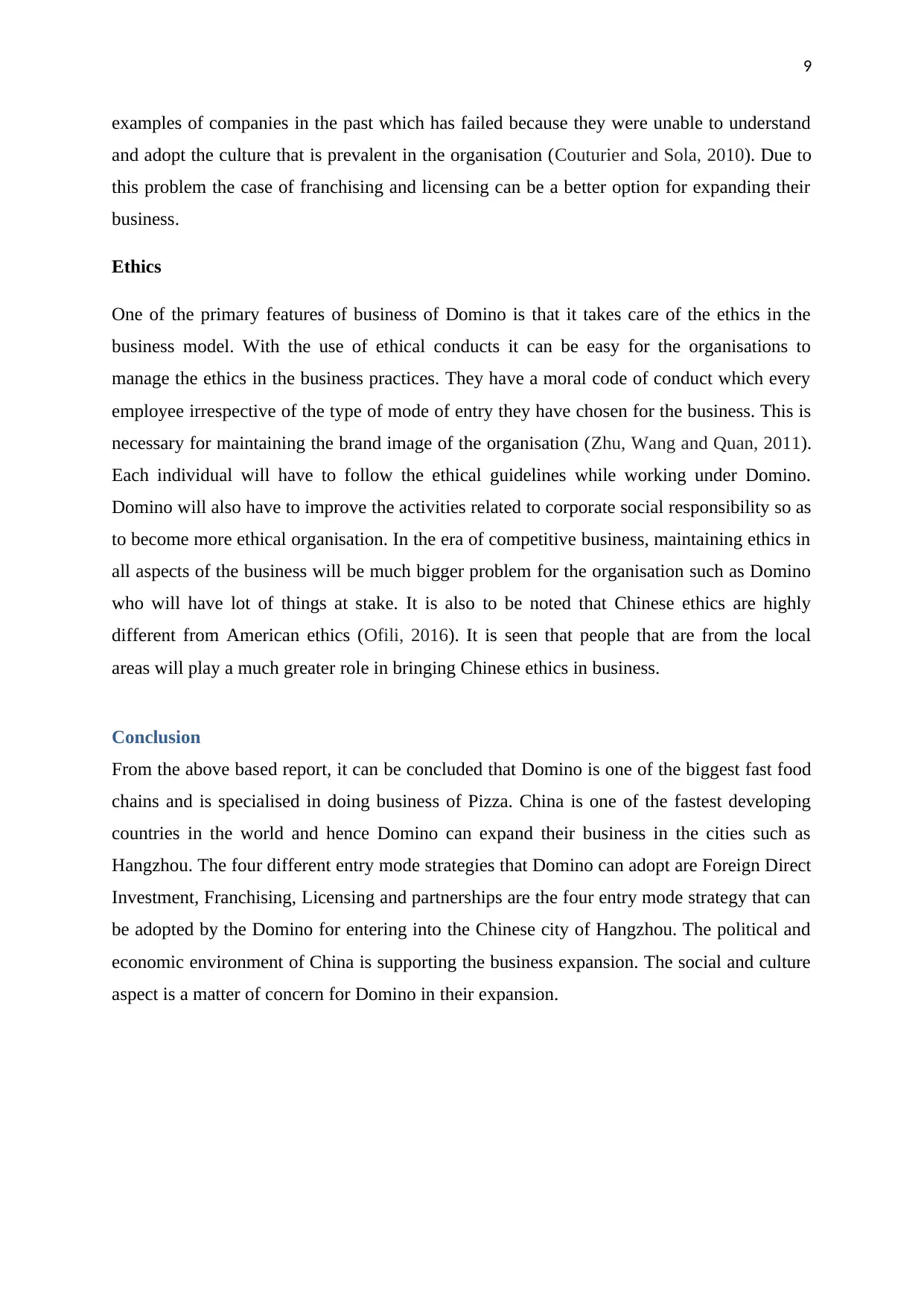
9
examples of companies in the past which has failed because they were unable to understand
and adopt the culture that is prevalent in the organisation (Couturier and Sola, 2010). Due to
this problem the case of franchising and licensing can be a better option for expanding their
business.
Ethics
One of the primary features of business of Domino is that it takes care of the ethics in the
business model. With the use of ethical conducts it can be easy for the organisations to
manage the ethics in the business practices. They have a moral code of conduct which every
employee irrespective of the type of mode of entry they have chosen for the business. This is
necessary for maintaining the brand image of the organisation (Zhu, Wang and Quan, 2011).
Each individual will have to follow the ethical guidelines while working under Domino.
Domino will also have to improve the activities related to corporate social responsibility so as
to become more ethical organisation. In the era of competitive business, maintaining ethics in
all aspects of the business will be much bigger problem for the organisation such as Domino
who will have lot of things at stake. It is also to be noted that Chinese ethics are highly
different from American ethics (Ofili, 2016). It is seen that people that are from the local
areas will play a much greater role in bringing Chinese ethics in business.
Conclusion
From the above based report, it can be concluded that Domino is one of the biggest fast food
chains and is specialised in doing business of Pizza. China is one of the fastest developing
countries in the world and hence Domino can expand their business in the cities such as
Hangzhou. The four different entry mode strategies that Domino can adopt are Foreign Direct
Investment, Franchising, Licensing and partnerships are the four entry mode strategy that can
be adopted by the Domino for entering into the Chinese city of Hangzhou. The political and
economic environment of China is supporting the business expansion. The social and culture
aspect is a matter of concern for Domino in their expansion.
examples of companies in the past which has failed because they were unable to understand
and adopt the culture that is prevalent in the organisation (Couturier and Sola, 2010). Due to
this problem the case of franchising and licensing can be a better option for expanding their
business.
Ethics
One of the primary features of business of Domino is that it takes care of the ethics in the
business model. With the use of ethical conducts it can be easy for the organisations to
manage the ethics in the business practices. They have a moral code of conduct which every
employee irrespective of the type of mode of entry they have chosen for the business. This is
necessary for maintaining the brand image of the organisation (Zhu, Wang and Quan, 2011).
Each individual will have to follow the ethical guidelines while working under Domino.
Domino will also have to improve the activities related to corporate social responsibility so as
to become more ethical organisation. In the era of competitive business, maintaining ethics in
all aspects of the business will be much bigger problem for the organisation such as Domino
who will have lot of things at stake. It is also to be noted that Chinese ethics are highly
different from American ethics (Ofili, 2016). It is seen that people that are from the local
areas will play a much greater role in bringing Chinese ethics in business.
Conclusion
From the above based report, it can be concluded that Domino is one of the biggest fast food
chains and is specialised in doing business of Pizza. China is one of the fastest developing
countries in the world and hence Domino can expand their business in the cities such as
Hangzhou. The four different entry mode strategies that Domino can adopt are Foreign Direct
Investment, Franchising, Licensing and partnerships are the four entry mode strategy that can
be adopted by the Domino for entering into the Chinese city of Hangzhou. The political and
economic environment of China is supporting the business expansion. The social and culture
aspect is a matter of concern for Domino in their expansion.
Paraphrase This Document
Need a fresh take? Get an instant paraphrase of this document with our AI Paraphraser
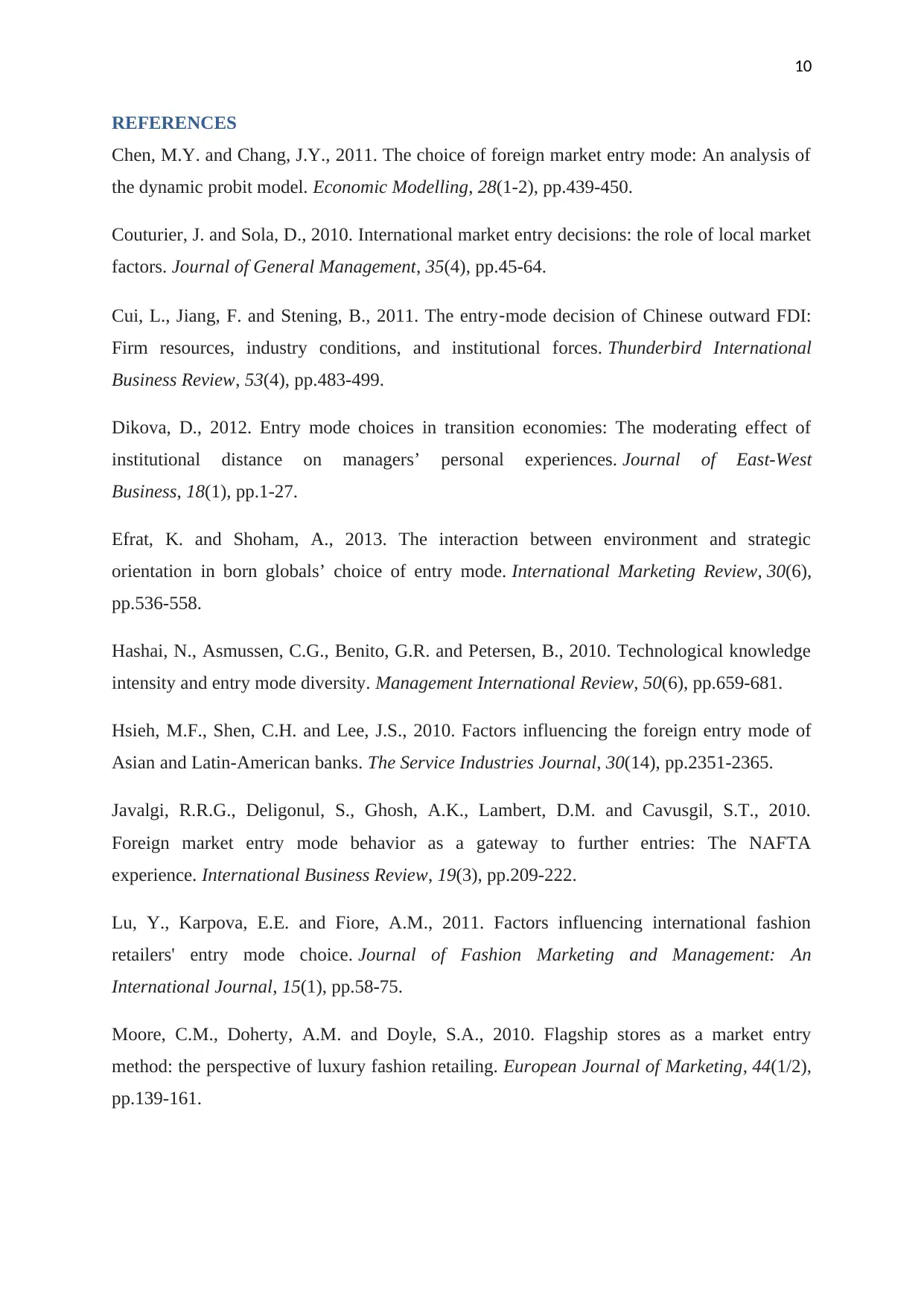
10
REFERENCES
Chen, M.Y. and Chang, J.Y., 2011. The choice of foreign market entry mode: An analysis of
the dynamic probit model. Economic Modelling, 28(1-2), pp.439-450.
Couturier, J. and Sola, D., 2010. International market entry decisions: the role of local market
factors. Journal of General Management, 35(4), pp.45-64.
Cui, L., Jiang, F. and Stening, B., 2011. The entry‐mode decision of Chinese outward FDI:
Firm resources, industry conditions, and institutional forces. Thunderbird International
Business Review, 53(4), pp.483-499.
Dikova, D., 2012. Entry mode choices in transition economies: The moderating effect of
institutional distance on managers’ personal experiences. Journal of East-West
Business, 18(1), pp.1-27.
Efrat, K. and Shoham, A., 2013. The interaction between environment and strategic
orientation in born globals’ choice of entry mode. International Marketing Review, 30(6),
pp.536-558.
Hashai, N., Asmussen, C.G., Benito, G.R. and Petersen, B., 2010. Technological knowledge
intensity and entry mode diversity. Management International Review, 50(6), pp.659-681.
Hsieh, M.F., Shen, C.H. and Lee, J.S., 2010. Factors influencing the foreign entry mode of
Asian and Latin-American banks. The Service Industries Journal, 30(14), pp.2351-2365.
Javalgi, R.R.G., Deligonul, S., Ghosh, A.K., Lambert, D.M. and Cavusgil, S.T., 2010.
Foreign market entry mode behavior as a gateway to further entries: The NAFTA
experience. International Business Review, 19(3), pp.209-222.
Lu, Y., Karpova, E.E. and Fiore, A.M., 2011. Factors influencing international fashion
retailers' entry mode choice. Journal of Fashion Marketing and Management: An
International Journal, 15(1), pp.58-75.
Moore, C.M., Doherty, A.M. and Doyle, S.A., 2010. Flagship stores as a market entry
method: the perspective of luxury fashion retailing. European Journal of Marketing, 44(1/2),
pp.139-161.
REFERENCES
Chen, M.Y. and Chang, J.Y., 2011. The choice of foreign market entry mode: An analysis of
the dynamic probit model. Economic Modelling, 28(1-2), pp.439-450.
Couturier, J. and Sola, D., 2010. International market entry decisions: the role of local market
factors. Journal of General Management, 35(4), pp.45-64.
Cui, L., Jiang, F. and Stening, B., 2011. The entry‐mode decision of Chinese outward FDI:
Firm resources, industry conditions, and institutional forces. Thunderbird International
Business Review, 53(4), pp.483-499.
Dikova, D., 2012. Entry mode choices in transition economies: The moderating effect of
institutional distance on managers’ personal experiences. Journal of East-West
Business, 18(1), pp.1-27.
Efrat, K. and Shoham, A., 2013. The interaction between environment and strategic
orientation in born globals’ choice of entry mode. International Marketing Review, 30(6),
pp.536-558.
Hashai, N., Asmussen, C.G., Benito, G.R. and Petersen, B., 2010. Technological knowledge
intensity and entry mode diversity. Management International Review, 50(6), pp.659-681.
Hsieh, M.F., Shen, C.H. and Lee, J.S., 2010. Factors influencing the foreign entry mode of
Asian and Latin-American banks. The Service Industries Journal, 30(14), pp.2351-2365.
Javalgi, R.R.G., Deligonul, S., Ghosh, A.K., Lambert, D.M. and Cavusgil, S.T., 2010.
Foreign market entry mode behavior as a gateway to further entries: The NAFTA
experience. International Business Review, 19(3), pp.209-222.
Lu, Y., Karpova, E.E. and Fiore, A.M., 2011. Factors influencing international fashion
retailers' entry mode choice. Journal of Fashion Marketing and Management: An
International Journal, 15(1), pp.58-75.
Moore, C.M., Doherty, A.M. and Doyle, S.A., 2010. Flagship stores as a market entry
method: the perspective of luxury fashion retailing. European Journal of Marketing, 44(1/2),
pp.139-161.
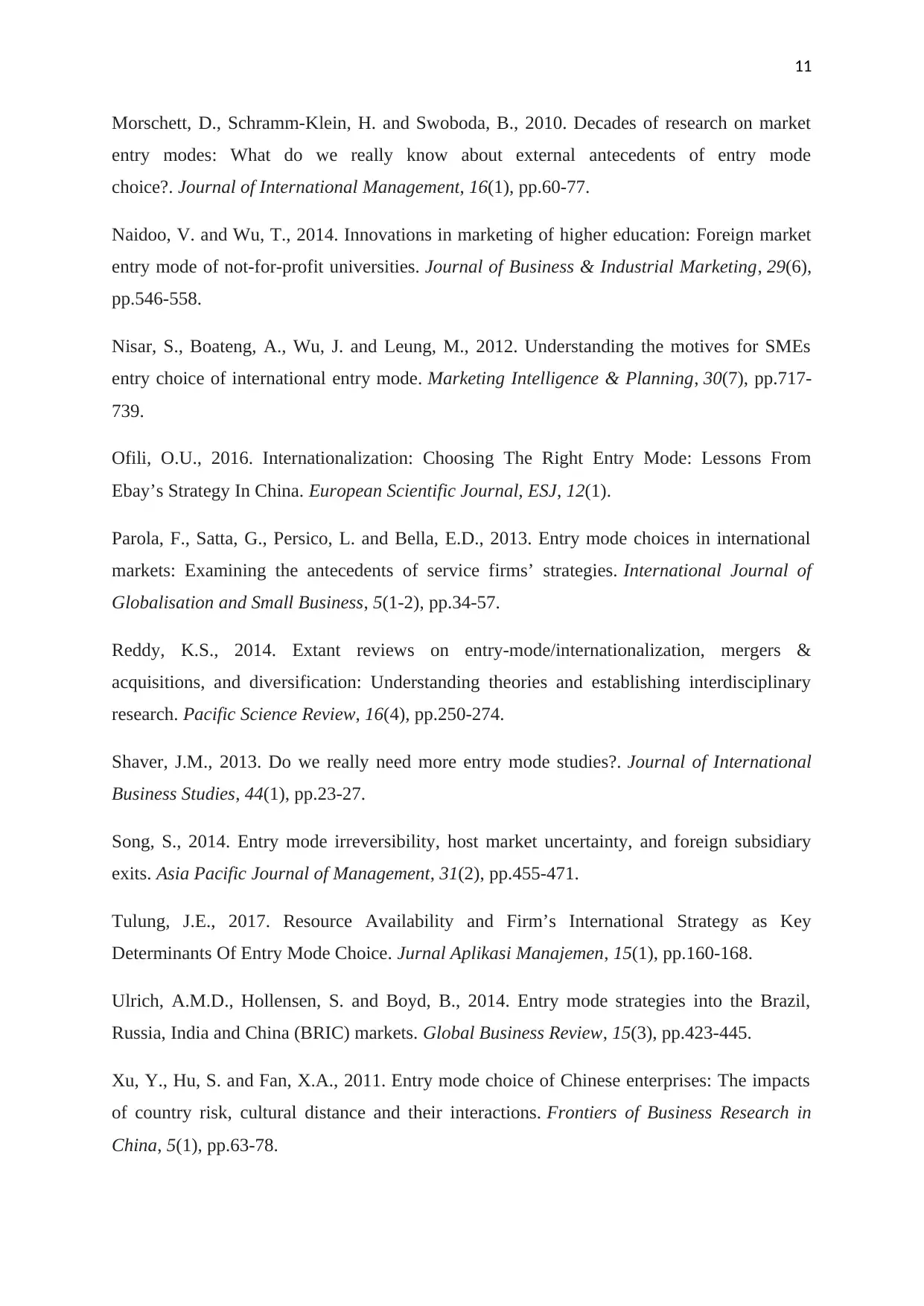
11
Morschett, D., Schramm-Klein, H. and Swoboda, B., 2010. Decades of research on market
entry modes: What do we really know about external antecedents of entry mode
choice?. Journal of International Management, 16(1), pp.60-77.
Naidoo, V. and Wu, T., 2014. Innovations in marketing of higher education: Foreign market
entry mode of not-for-profit universities. Journal of Business & Industrial Marketing, 29(6),
pp.546-558.
Nisar, S., Boateng, A., Wu, J. and Leung, M., 2012. Understanding the motives for SMEs
entry choice of international entry mode. Marketing Intelligence & Planning, 30(7), pp.717-
739.
Ofili, O.U., 2016. Internationalization: Choosing The Right Entry Mode: Lessons From
Ebay’s Strategy In China. European Scientific Journal, ESJ, 12(1).
Parola, F., Satta, G., Persico, L. and Bella, E.D., 2013. Entry mode choices in international
markets: Examining the antecedents of service firms’ strategies. International Journal of
Globalisation and Small Business, 5(1-2), pp.34-57.
Reddy, K.S., 2014. Extant reviews on entry-mode/internationalization, mergers &
acquisitions, and diversification: Understanding theories and establishing interdisciplinary
research. Pacific Science Review, 16(4), pp.250-274.
Shaver, J.M., 2013. Do we really need more entry mode studies?. Journal of International
Business Studies, 44(1), pp.23-27.
Song, S., 2014. Entry mode irreversibility, host market uncertainty, and foreign subsidiary
exits. Asia Pacific Journal of Management, 31(2), pp.455-471.
Tulung, J.E., 2017. Resource Availability and Firm’s International Strategy as Key
Determinants Of Entry Mode Choice. Jurnal Aplikasi Manajemen, 15(1), pp.160-168.
Ulrich, A.M.D., Hollensen, S. and Boyd, B., 2014. Entry mode strategies into the Brazil,
Russia, India and China (BRIC) markets. Global Business Review, 15(3), pp.423-445.
Xu, Y., Hu, S. and Fan, X.A., 2011. Entry mode choice of Chinese enterprises: The impacts
of country risk, cultural distance and their interactions. Frontiers of Business Research in
China, 5(1), pp.63-78.
Morschett, D., Schramm-Klein, H. and Swoboda, B., 2010. Decades of research on market
entry modes: What do we really know about external antecedents of entry mode
choice?. Journal of International Management, 16(1), pp.60-77.
Naidoo, V. and Wu, T., 2014. Innovations in marketing of higher education: Foreign market
entry mode of not-for-profit universities. Journal of Business & Industrial Marketing, 29(6),
pp.546-558.
Nisar, S., Boateng, A., Wu, J. and Leung, M., 2012. Understanding the motives for SMEs
entry choice of international entry mode. Marketing Intelligence & Planning, 30(7), pp.717-
739.
Ofili, O.U., 2016. Internationalization: Choosing The Right Entry Mode: Lessons From
Ebay’s Strategy In China. European Scientific Journal, ESJ, 12(1).
Parola, F., Satta, G., Persico, L. and Bella, E.D., 2013. Entry mode choices in international
markets: Examining the antecedents of service firms’ strategies. International Journal of
Globalisation and Small Business, 5(1-2), pp.34-57.
Reddy, K.S., 2014. Extant reviews on entry-mode/internationalization, mergers &
acquisitions, and diversification: Understanding theories and establishing interdisciplinary
research. Pacific Science Review, 16(4), pp.250-274.
Shaver, J.M., 2013. Do we really need more entry mode studies?. Journal of International
Business Studies, 44(1), pp.23-27.
Song, S., 2014. Entry mode irreversibility, host market uncertainty, and foreign subsidiary
exits. Asia Pacific Journal of Management, 31(2), pp.455-471.
Tulung, J.E., 2017. Resource Availability and Firm’s International Strategy as Key
Determinants Of Entry Mode Choice. Jurnal Aplikasi Manajemen, 15(1), pp.160-168.
Ulrich, A.M.D., Hollensen, S. and Boyd, B., 2014. Entry mode strategies into the Brazil,
Russia, India and China (BRIC) markets. Global Business Review, 15(3), pp.423-445.
Xu, Y., Hu, S. and Fan, X.A., 2011. Entry mode choice of Chinese enterprises: The impacts
of country risk, cultural distance and their interactions. Frontiers of Business Research in
China, 5(1), pp.63-78.
⊘ This is a preview!⊘
Do you want full access?
Subscribe today to unlock all pages.

Trusted by 1+ million students worldwide
1 out of 13
Related Documents
Your All-in-One AI-Powered Toolkit for Academic Success.
+13062052269
info@desklib.com
Available 24*7 on WhatsApp / Email
![[object Object]](/_next/static/media/star-bottom.7253800d.svg)
Unlock your academic potential
Copyright © 2020–2025 A2Z Services. All Rights Reserved. Developed and managed by ZUCOL.




